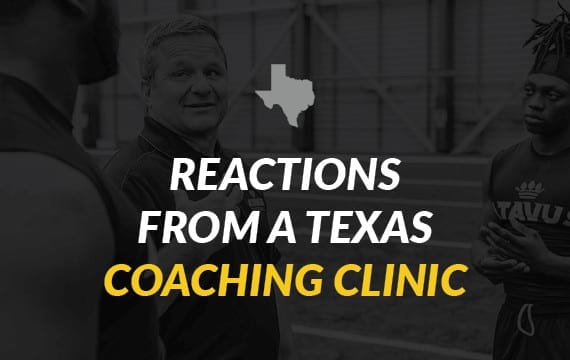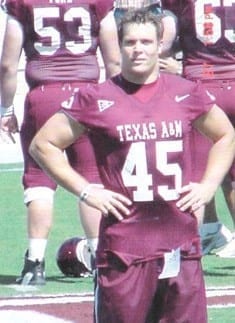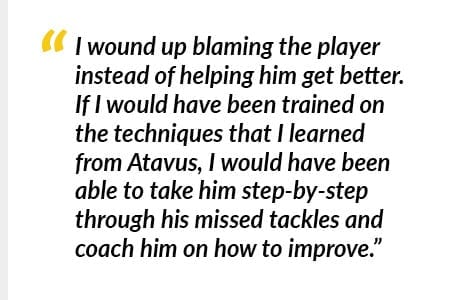| Former Texas A&M player and high school coach Jared Morris shares his thoughts after attending an Atavus tackling clinic |

Taylor Kempf, Mar. 27th 2020
Jared Morris was a three-year starter at Brownwood high school in Texas. As a senior in 1998, he was a first-team All-State selection at linebacker and had 114 unassisted tackles that year, 16 for losses, and assisted on 68 others. During his career, he was credited with 242 solo tackles and assisted on 219 others.
He earned a starting linebacker position his sophomore year at Texas A&M and led the team in tackles until being injured. He was named to the Butkus Award watch list during his senior year. After recording a personal best record of 18 tackles in the opening game, he suffered a career ending knee injury the second game of the season.

After college, Morris became a high school football coach. In March 2019, he attended an Atavus coaching clinic; below he shares his thoughts on the experience.
The game of football can teach us many things about ourselves. We can use the sport as a tool to capitalize on our strengths and improve our weaknesses, or we can rely on it so much that it buries us with anxiety and even depression. It has an amazing ability to transcend our lives and provide opportunities that are both extraordinary and scary. As in most things in life, it is up to us to choose how things affect us, and what how we deal with challenges as they emerge.
As a former linebacker at a Texas A&M University, I have experienced many opportunities that a kid born in a rural town of 400 people doesn’t usually afford. And it was in Uvalde, TX, that I found my most recent opportunity to meet and talk with Coach Randy Mayes and learn of the new tackling techniques being taught to coaches across the state of Texas. The Texas High School Coaches Association has partnered with Atavus, a company dedicated to transforming the way football players tackle, to train coaches in the safest and best techniques for players to tackle.
I have seen quarterbacks receive intense training in position specific techniques. I’ve personally taken offensive lineman through repetitive footwork drills that have blown out many soles. Defensive linemen are becoming Jiu Jitsu masters with their hand technique. But Atavus is the first team of coaches and doctors that I have seen approach tackle performance in terms of both safety and results.
In the new world of football, where concerns over concussions and CTE are impacting participation in football programs across the nation, we must make the game safer whenever possible. As a former coach at the high school level, I know how easy it is to think of safer as less effective. I was an old-school, smash-mouth player and it would be easy for me to think that the way I played is the best or only way to coach. After attending a half day of training with Coach Mayes and Atavus coach Kellen Gordon, I was convinced that the Atavus shoulder-led tackle is safer tackle and a better tackle: better for the player, better for the team, better for the coach, and better for the game.
Old-school football was about running the ball and controlling the clock. In the newest form of offensive football, you could pretty much say, “If you can’t throw the ball effectively, you can’t win.” Well, as a former linebacker, I still believe that defense wins championships. And if a team can’t tackle well, they can’t win championships.
During my career as a high school coach, I was at a top 6A program that was busting at the seams with collegiate talent. Our defensive coordinator moved to the head coach position at a school down the road and a few of us were able to go with him. This school had not won a game in two years so we had some work to do. We had to start at the beginning and teach basics and fundamentals. These kids were thirsty for success and they bought in from the beginning. I was shocked at how easy they were to coach. For my linebackers, I always stressed that their first two steps would determine their success on every play. These were not star athletes and they could not rely on their athleticism or speed to make it to the ball. If they took a false step, they would rarely be involved in the play. Every week I saw improvement and it didn’t take long before we were consistently getting to the ball. But bringing the ball carrier down became the first major hurdle as a coach with this group. We had to tackle better and I had to learn to teach something that I was just naturally pretty good at.
As a defensive coaching staff, we emphasized tackling circuits, and of course we used the common coach speak of ‘head across,’ ‘wrap up,’ ‘grab cloth,’ or ‘run your feet on contact.’ We saw small improvements, but the results weren’t coming fast enough. When my 175 pound middle linebacker pulled me aside and asked how he could make more tackles, a kid that knew how to read blocking schemes and be in the right spot, I had to resort to things like “you have to want it more,” or “get tougher.” I wound up blaming the player instead of helping him get better. If I would have been trained on the techniques that I learned from Atavus, I would have been able to take him step-by-step through his missed tackles and coach him on how to improve.

This is just a small, personal story of how I think Atavus could have made a difference for my players if I would have known about this tackling technique. The techniques are safer, but can also improve the performance of players and defenses as a whole. Atavus is able to track tackle success, yards after contact, and many defensive stats that can show overall defensive improvements. Why would a staff not be on the forefront of improving their player performance as well as their health? As mentioned, I’ve seen extraordinary techniques and technology used to improve the play of the most important position on the offensive side of the ball. The production of the quarterback has been dissected, tinkered, and enhanced beyond that of any player on the field. The most important result of every play on the defensive side of the ball is the tackle and how well it is performed. Atavus tackling techniques can make your defensive players better.
Football continues to provide privileges that I could never have imagined, but comes with some risk. Should I let my kids take on that risk? It is a question that, fair or unfair, parents are asking themselves every day. Not playing would rob my kids of so many opportunities to learn life’s lessons that are essential to growing up. As coaches, we must embrace this challenge and educate ourselves and parents by using the safest techniques for our players. Life has taught me that it is coaches’ responsibility to do it. The most important thing is that young players across the nation will also learn the best skills to find success in tackling.